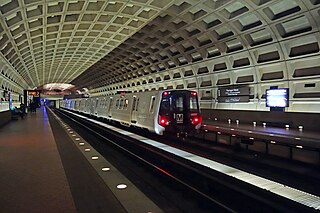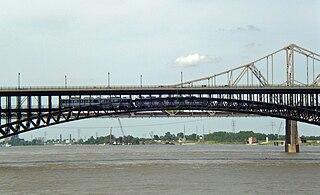Madison Metro may refer to:
- Madison metropolitan area, the metropolitan area surrounding the city of Madison, Wisconsin
- Metro Transit (Madison), formerly Madison Metro, public transit system in the above
Madison Metro may refer to:

The Washington Metro, often abbreviated as the Metro and formally the Metrorail, is a rapid transit system serving the Washington metropolitan area of the United States. It is administered by the Washington Metropolitan Area Transit Authority (WMATA), which also operates the Metrobus service under the Metro name. Opened in 1976, the network now includes six lines, 98 stations, and 129 miles (208 km) of route.
Metropolitan Area Express may refer to:
Metro, short for metropolitan, may refer to:

The Metropolitan Council, commonly abbreviated Met Council or Metro Council, is the regional governmental agency and metropolitan planning organization in Minnesota serving the Twin Cities seven-county metropolitan area, accounting for over 55 percent of the state's population.

The Maryland Transit Administration (MTA) is a state-operated mass transit administration in Maryland, and is part of the Maryland Department of Transportation. The MTA operates a comprehensive transit system throughout the Washington-Baltimore metropolitan area. There are 80 bus lines serving the Baltimore Metropolitan Area, along with rail services that include the Light Rail, Metro Subway, and MARC Train. In 2023, the system had a ridership of 52,922,000, or about 219,600 per weekday as of the second quarter of 2024.

The Yellow Line is a rapid transit line of the Washington Metro system that runs between Huntington in Virginia and Mount Vernon Square in Washington, D.C. It consists of 13 stations in Fairfax County, the city of Alexandria, and Arlington County in Virginia, and Washington, D.C. It is the shortest line in the system, and since its truncation to Mount Vernon Square, it is the only line that does not enter Maryland.

College Park–University of Maryland station is a Washington Metro and MARC station located in College Park, Maryland, near the University of Maryland, College Park campus. It is served by the Metro Green Line and limited service on the MARC Camden Line. The light rail Purple Line is planned to begin service at the station in 2027.
Metropolitan may refer to:
Metrolink, MetroLink, or Metro-link is the name of several transport services throughout the world:

King County Metro, officially the King County Metro Transit Department and often shortened to Metro, is the public transit authority of King County, Washington, which includes the city of Seattle. It is the eighth-largest transit bus agency in the United States. In 2023, the system had a ridership of 78,121,600, or about 281,300 per weekday as of the second quarter of 2024. Metro employs 2,477 full-time and part-time operators and operates 1,540 buses.

The Washington Metropolitan Area Transit Authority, commonly referred to as Metro, is a tri-jurisdictional public transit agency operates transit service in the Washington metropolitan area. WMATA provides rapid transit service under the Metrorail name, fixed-route bus service under the Metrobus brand, and paratransit service under the MetroAccess brand. In 2023, the system had a ridership of 239,741,800, or about 975,800 per weekday as of the second quarter of 2024.
Metro Transit may refer to:
Metropolitan Transit/Transportation Commission/Corporation may refer to:
The Metro East is an urban area in Southern Illinois, United States that contains the eastern and northern urban, suburban, and exurban areas across the Mississippi River from St. Louis, Missouri. It encompasses eight counties in the Greater St. Louis area and constitutes the second-most populous metropolitan area in Illinois.

McLean station is a Washington Metro station in Fairfax County, Virginia, on the Silver Line. The station is located in Tysons, with a McLean postal address. It began operation on July 26, 2014.

Transportation in Greater St. Louis, Missouri includes road, rail, ship, and air transportation modes connecting the bi-state St. Louis metropolitan area with surrounding communities throughout the Midwest, national transportation networks, and international locations. The Greater St. Louis region also supports a multi-modal transportation network that includes bus, paratransit, and light rail service in addition to shared-use paths, bike lanes and greenways.
Metro Transit, formerly Madison Metro, operates bus services throughout the City of Madison, Wisconsin, United States and several of its suburbs, including Middleton, Fitchburg, Maple Bluff, Shorewood Hills, Sun Prairie, and Verona. System-wide, fixed route ridership was 9,514,620 in 2023. Metro Transit also provides supplemental transit services to Madison's high schools. These routes have been designed to provide additional services during peak school times. Metro Transit also serves the University of Wisconsin–Madison campus, Eagle Heights University apartments, and some off-campus residential areas, via routes 80, 81, 82, and 84. These routes are free of charge for UW students and faculty.

Symphony station, formerly University Street station, is a light rail station that is part of the Downtown Seattle Transit Tunnel in Seattle, Washington, United States. The station is located under 3rd Avenue at University Street, near Benaroya Hall, and is served by Sound Transit's 1 Line. It is located between Westlake and Pioneer Square stations and has surface connections to buses operated by King County Metro and other providers.

MetroBus is a public bus service operated by Metro Transit that serves the Greater St. Louis area. In 2023, the service had an annual ridership of 12,531,400, or about 41,400 per weekday as of the second quarter of 2024.

Grand Central Madison is a commuter rail terminal for the Long Island Rail Road (LIRR) in the Midtown East neighborhood of Manhattan in New York City. Part of the East Side Access project, the new terminal started construction in 2008 and opened on January 25, 2023. The station sits beneath Grand Central Terminal, which serves the Metropolitan Transportation Authority (MTA)'s Metro-North Railroad.